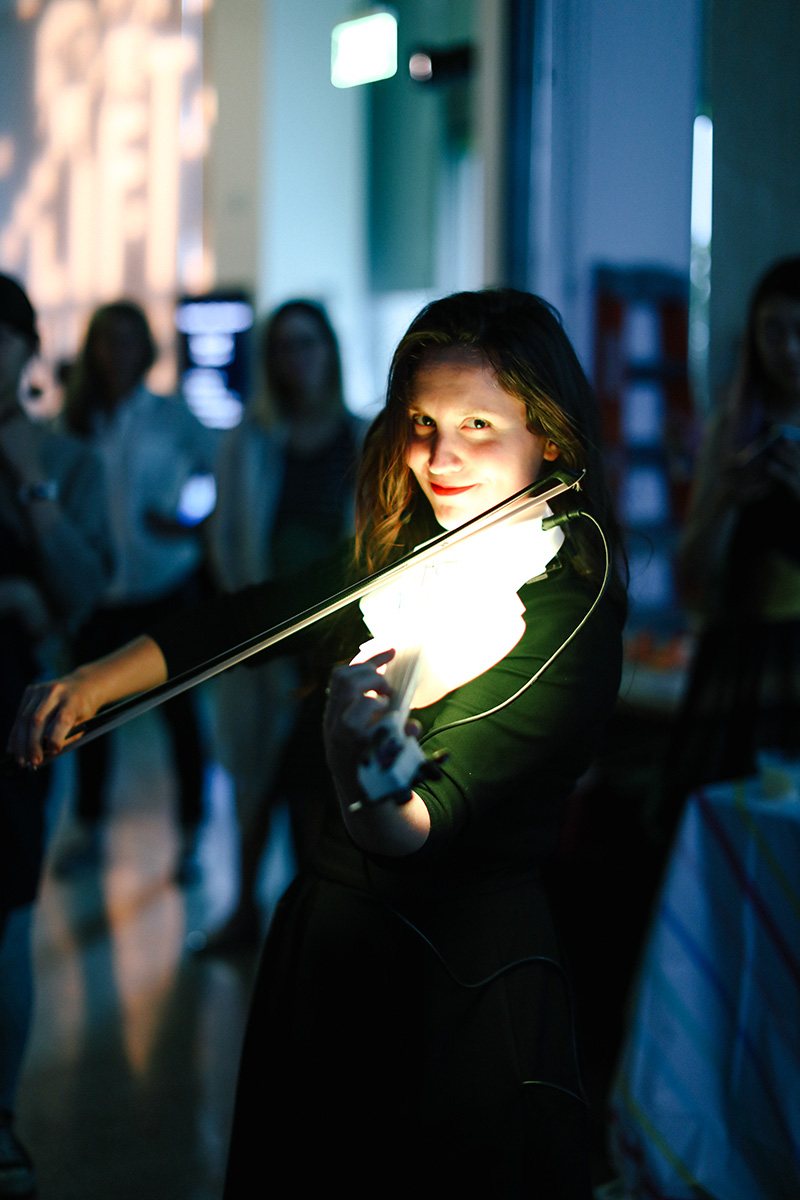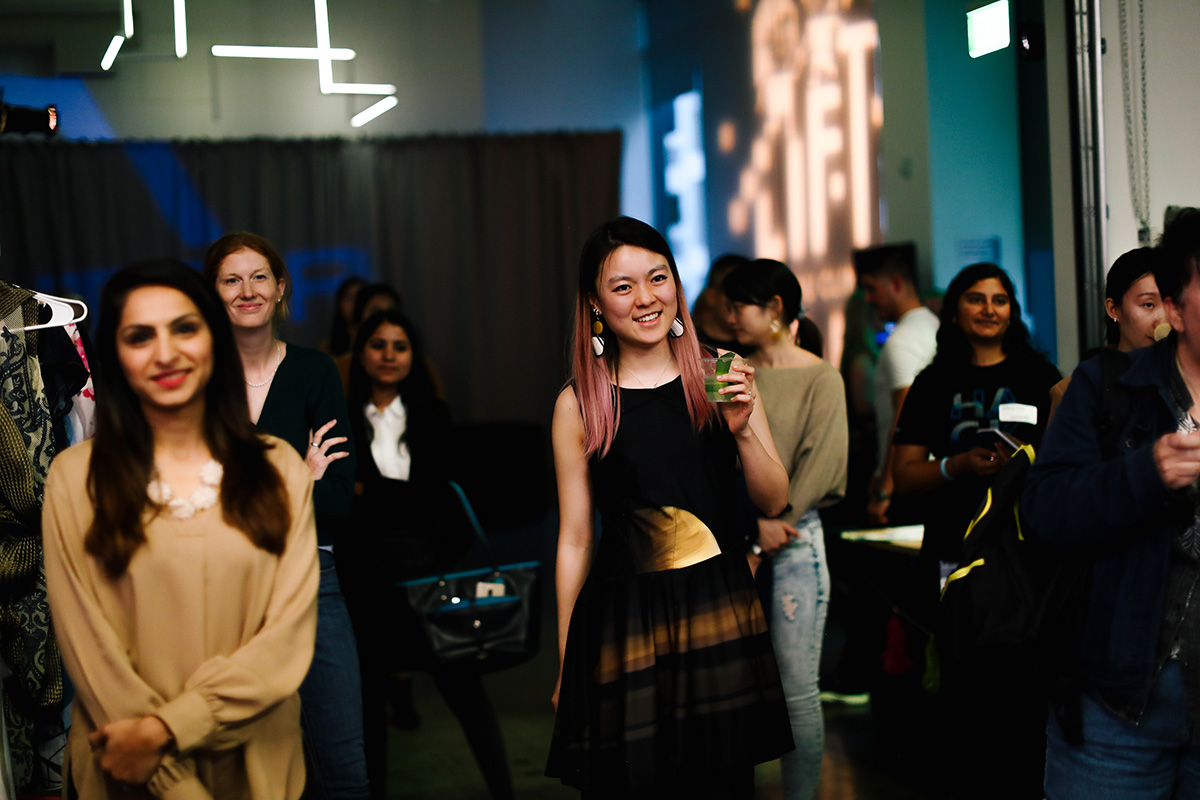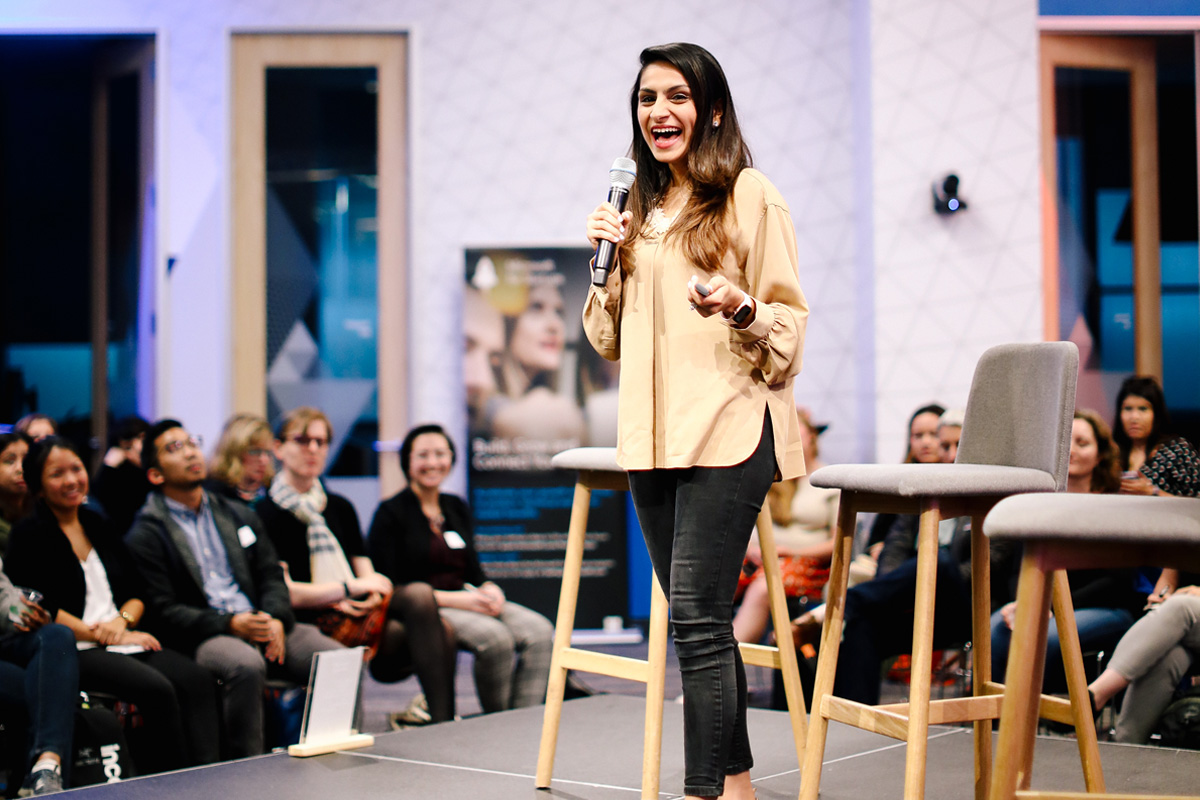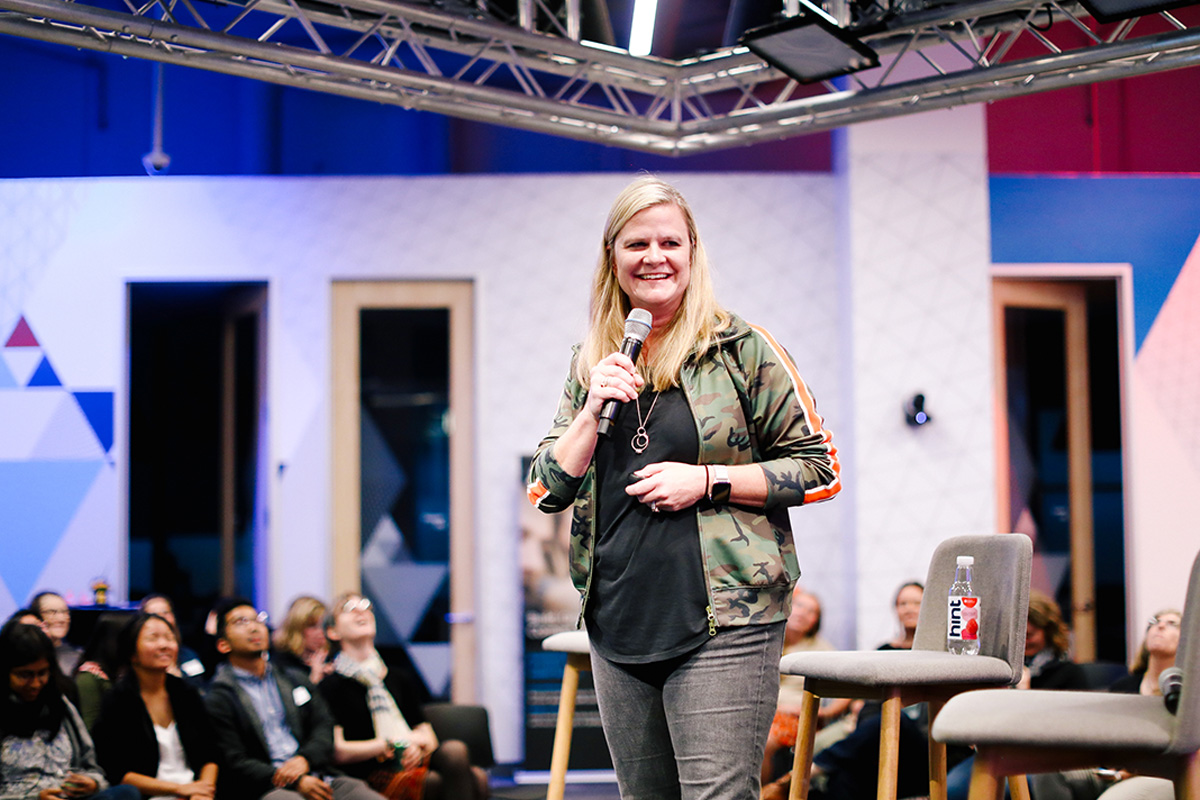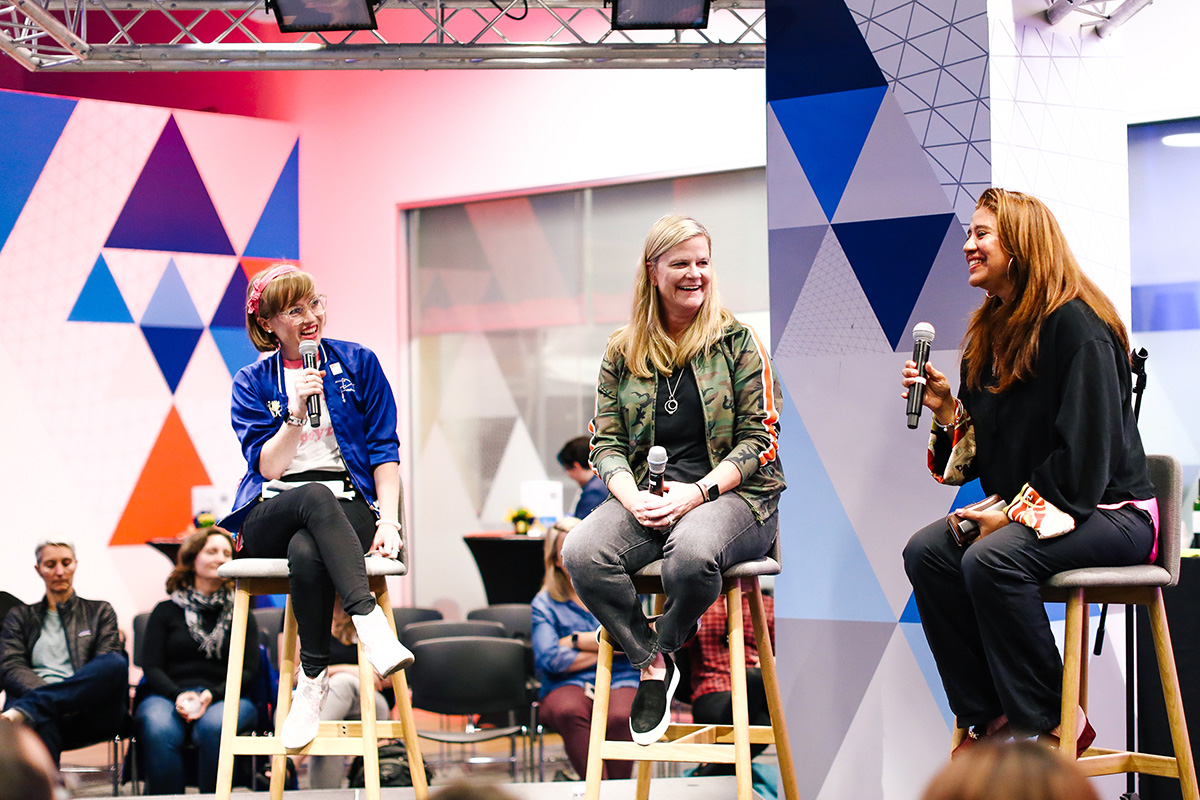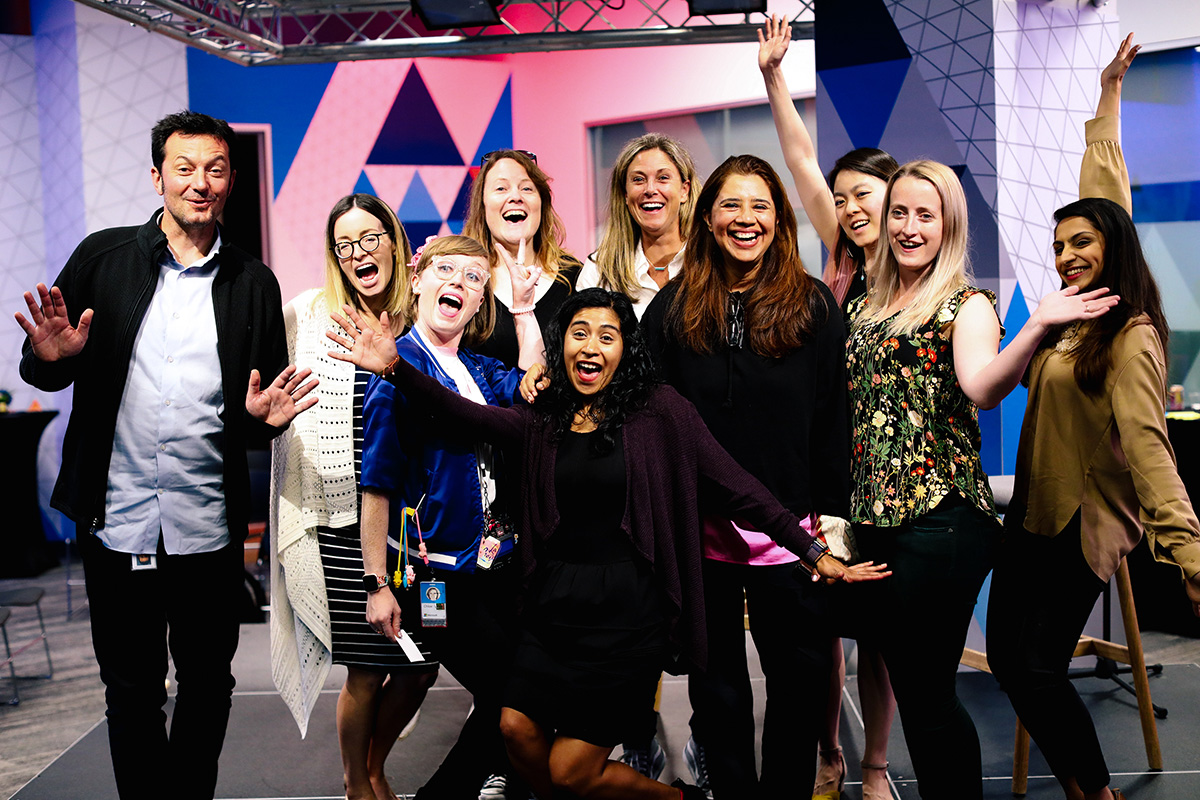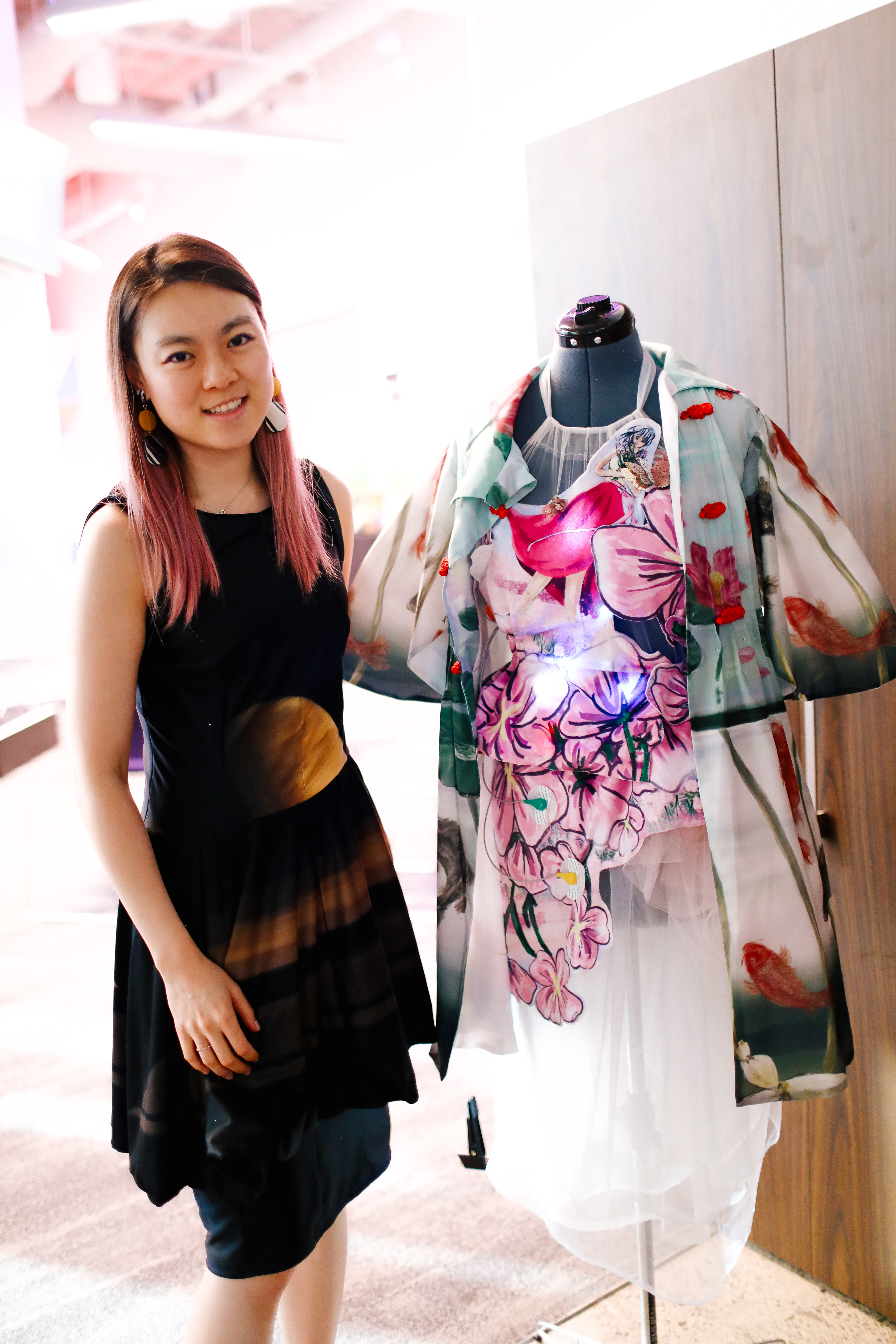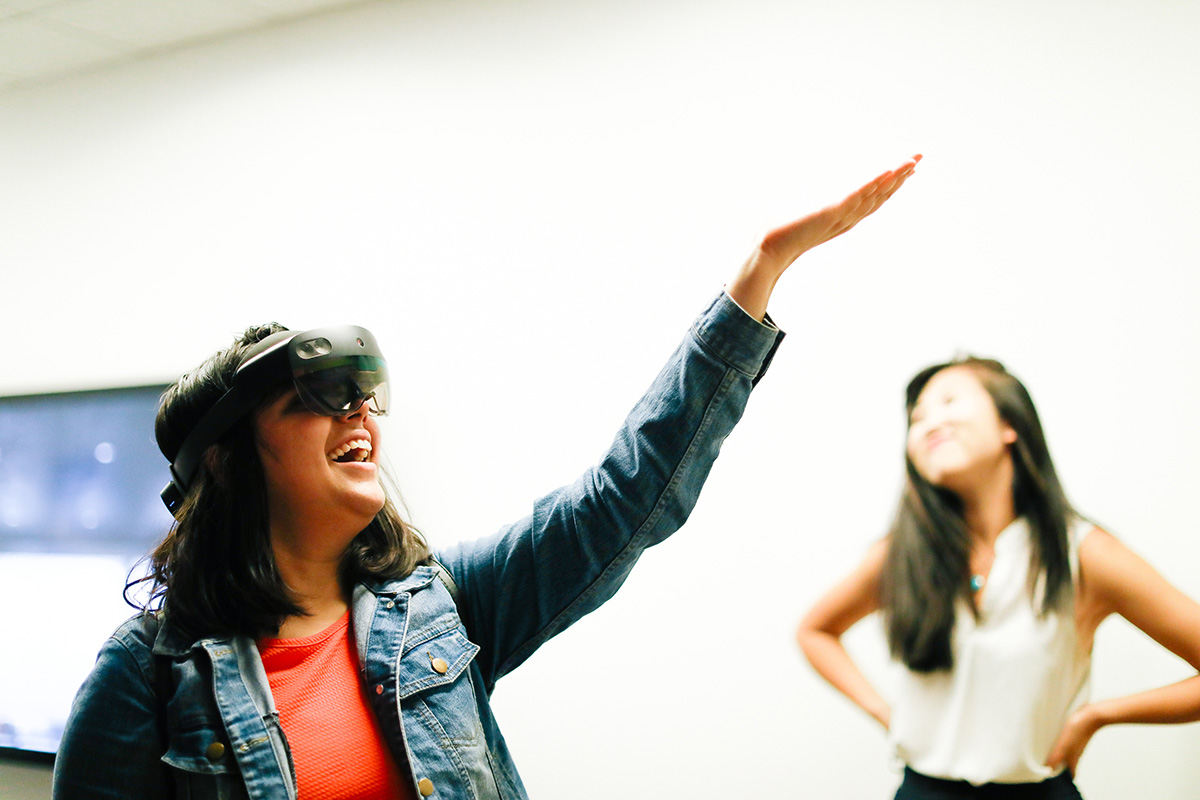Like what you see here? Our mission-aligned Girl Geek X partners are hiring!
- See open jobs at Microsoft and check out open jobs at our trusted partner companies.
- Find more Microsoft Hardware Girl Geek Dinner photos from the event – please tag yourselves!
- Does your company want to sponsor a Girl Geek Dinner in 2021? Talk to us!
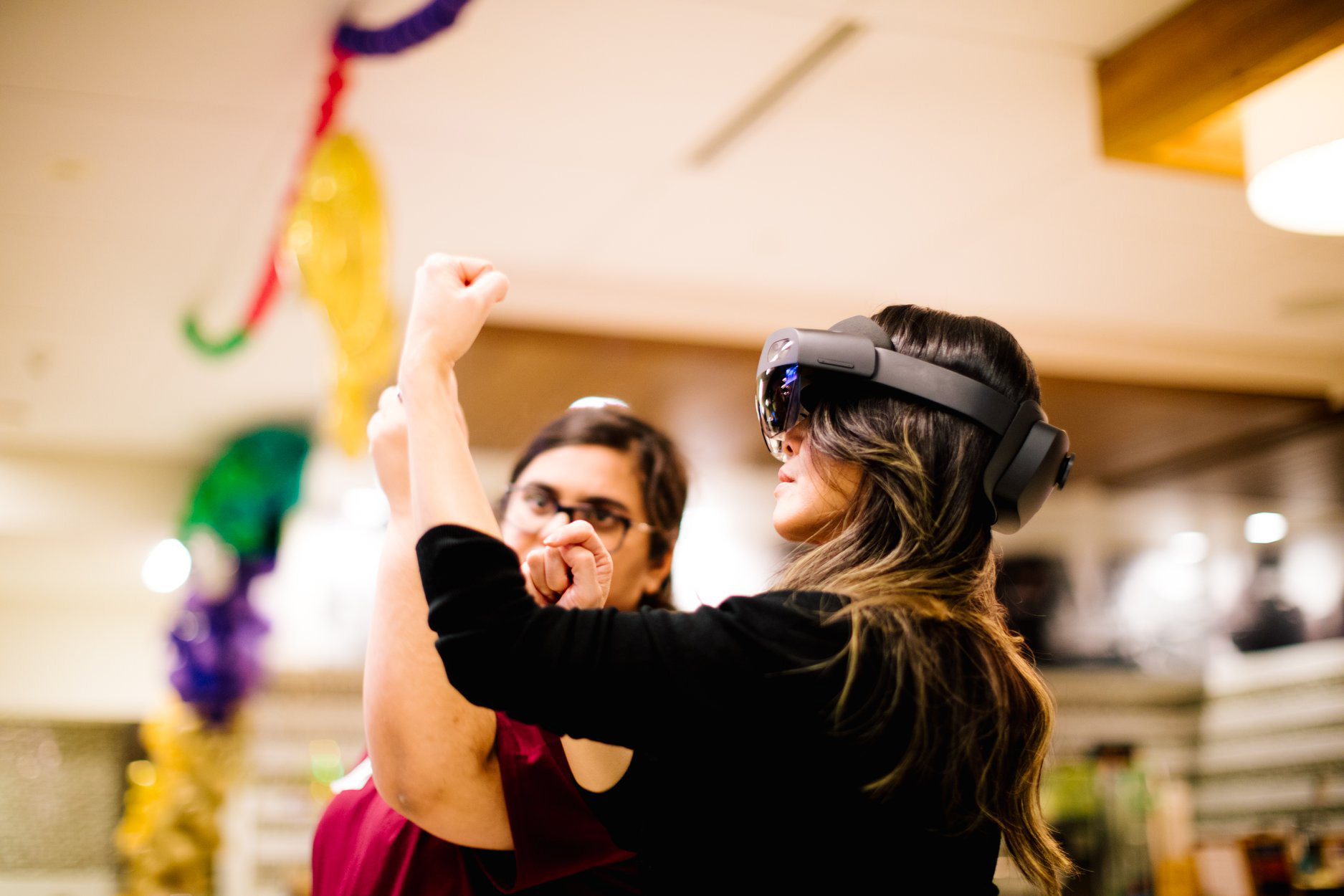 We enjoyed dinner and demos of HoloLens at the sold-out Microsoft Hardware Girl Geek Dinner in Sunnyvale, California. Erica Kawamoto Hsu / Girl Geek X
We enjoyed dinner and demos of HoloLens at the sold-out Microsoft Hardware Girl Geek Dinner in Sunnyvale, California. Erica Kawamoto Hsu / Girl Geek X
Transcript of Microsoft Hardware Girl Geek Dinner – Lightning Talks:
Angie Chang: Well, thank you so much for coming out tonight to Microsoft Hardware Girl Geek Dinner! My name is Angie Chang. I’m the founder of Girl Geek X. I’ve been doing this for about 12 years in the San Francisco Bay Area, and I’m really glad to see all of you out here tonight for this sold out event in San Jose —
Gretchen DeKnikker: Sunnyvale!
Angie Chang: Sunnyvale — sorry, I live in Berkeley! Thank you so much for coming out. Please talk to us. If you’re interested in hosting one of these at your company. The hashtag tonight is girlgeekxmicrosoft. If you want to tweet something really cool tonight, please do, share pictures, and share some of the awesome words that’ll be spoken by girl geeks tonight.
Gretchen DeKnikker: Yay, Angie. Yeah. She’s on tour right now, and she just can’t remember what city she’s in. It’s just like night after night, new city. It’s rough. Right? She’s livin’ that. Okay. How many people, it’s your first event? Cool. Welcome. We do these a lot, like several times a month, so you should definitely keep coming. I’m going to show you something right now. If you have been to four Girl Geek events, raise your hand. Keep them up if it’s five. Six, seven, eight, nine, ten, eleven. Okay. Oh, 12.
Gretchen DeKnikker: Okay, so you get these cards. It’s actually my little pixie on them. You get to carry me around in your pocket. How awkward is that? It’s pretty great. Okay, so we also have a podcast. Check that out. We’re just about to launch the new season where we’re answering your user questions. We sent out a survey. So that one will be really fun. We’re going to try some new things. Rate it, please. Give us feedback. Let us know because we don’t want to make stuff that nobody wants to listen to.
Gretchen DeKnikker: We also have a YouTube channel. Every time you can’t make it to one of these, you should make it because obviously, all of these awesome people come all the time. But if you can’t, they’re always on YouTube, subscribe to that. Then coming up on March 6th to kick off International Women’s weekend, because I’ve just extended it from a day to a weekend, because why not, we’re doing an all day long virtual event. It’s going to be epic. We have the Chief Diversity Officer of Workday. We’ve got the CTO of Intuit, the CMO of Twilio, the VP of Marketing from Intel AI. I can’t even list all of the amazing women that are going to spend the day with you and share all of their information, and also that will be available on YouTube later.
Gretchen DeKnikker: Self-promotion over, but this is all just for you. Please join me in welcoming your emcee for the night, Aaratee.
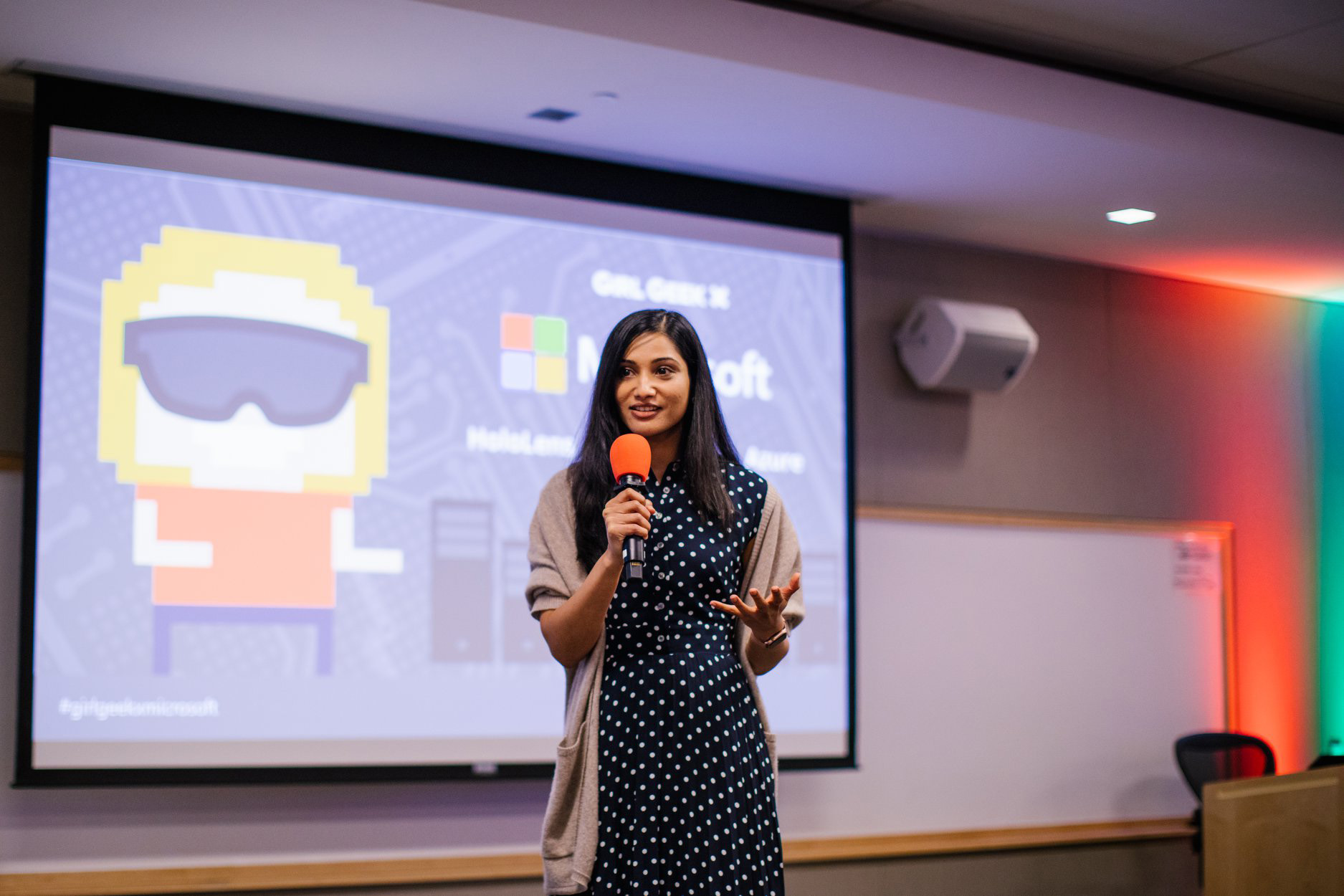 Microsoft Group Engineering Manager Aaratee Rao welcomes the audience and talks about her career at Microsoft Hardware Girl Geek Dinner. Erica Kawamoto Hsu / Girl Geek X
Microsoft Group Engineering Manager Aaratee Rao welcomes the audience and talks about her career at Microsoft Hardware Girl Geek Dinner. Erica Kawamoto Hsu / Girl Geek X
Aaratee Rao: Thank you, Angie and Gretchen. Good evening, everyone. My name is Aaratee Rao. I’m a group engineering manager at Microsoft Silicon Valley. I’m also the executive sponsor of diversity and inclusion for Microsoft’s Bay Area region. As your host for the evening, I would like to welcome you all and thank you for taking the time and joining us tonight. It is amazing to see so many like-minded women in the same room. I hope you all had a chance to mingle and network with each other. If not, don’t worry, we have some more networking time after the talks.
Aaratee Rao: We have a number of interesting talks to share with you this evening. But before that, I would like to take few minutes to introduce Microsoft Bay Area to you all, who we are, what we do, and how we work together to build innovative products at scale for our customers. I’ve been at Microsoft for only 14 months. So I wanted to start with a short story about my journey to Microsoft, and why I decided to join this company.
Aaratee Rao: I’m a recent hire into Microsoft, but not to the tech industry. I’ve been working in the tech industry for over 17 years now in a wide range of companies, from a startup, with less than 50 people, to a hyper growth company like Uber, where I worked for close to four years, and some organization grow from few hundreds to few thousands of employees. I’ve also worked at some large Fortune 500 companies like Visa, Intuit, and walmart.com.
Aaratee Rao: I started my career as an engineer, and then grew into leadership roles. Working at such a diverse set of companies for so many years gave me exposure to different technologies, products, industries, and also different company cultures. This exposure gave me clarity on what is really important to me as I’m exploring a new role, or a new company for my next career move. While I was working at Uber, and Microsoft approached me with a new exciting job opportunity, I applied that same criteria to Microsoft, which can be summarized into three things. Number one is people, number two is product, and number three is growth.
Aaratee Rao: Let me explain these three areas further and my decision to join Microsoft. My number one requirement was people. I believe that the most important driver of any company’s success is its culture, and the people who help build that culture. For many of us, a large portion of our day is spent at work. In fact, there is proven research data that one third of a lifetime is spent at work. So it is safe to say that our job and the people we work with can have a big impact on the quality of a life.
Aaratee Rao: Like many of you in the audience, I personally thrive in a workplace where people are not only passionate about what they’re doing, but they also create a supportive and respectful environment for everyone around them. I found all the Microsoft employees that I met as part of my interview process to be smart, humble, open to new ideas, and inclusive in their thinking, which I really liked. Microsoft employees are encouraged to apply growth mindset to their work every single day, which is a mindset shift from know it all to learn it all. It starts with a fundamental belief that every person can learn and develop.
Aaratee Rao: My number two requirement was product. Now, it is important to me that I’m working on a product that helps create a positive impact in people’s lives. Microsoft creates technology so that others can create more technology. In today’s world, every walk of life in every industry is being shaped by digital technology. Microsoft’s mission becomes even more important. I was also super thrilled to learn that Microsoft Bay Area teams work on a wide range of products, from the intelligent cloud offering Azure, which is using cutting edge technologies like AI and machine learning, to a product like Microsoft Teams, which is reinventing productivity and collaboration, and also Microsoft hardware teams that you will learn more about tonight from our speakers.
Aaratee Rao: My number third requirement was growth. Microsoft has seen tremendous growth over the past few years under Satya’s leadership. This growth has created more opportunities for employees to make an impact. Besides this, the company has also undergone a major culture transformation under the new leadership. Diversity and inclusion is a core priority for the company, and part of employee performance review. Microsoft leaders believe that for a company to be successful, and keep growing for a long period of time, we need more than a good idea and a good strategy. We need a culture that fosters growth and enables employees to build new capabilities. I was super happy to see Microsoft adopting open source technologies, and also giving back to the open source community.
Aaratee Rao: Clearly, Microsoft met all my requirements and exceeded my expectations. Here I am, and it’s been a fun and amazing ride so far. With that, let me introduce our Bay Area teams to you all. Bay Area is popularly known as a hub for innovation all around the world. Microsoft’s presence here, and all the product development that we do here is also rooted in innovation. Our presence here means that Microsoft can participate in conversations with startups. All employees, Bay Area employees embody that startups [inaudible] off the Silicon Valley to drive a company through innovation. We have offices in three locations: San Francisco, Berkeley, and Sunnyvale.
Aaratee Rao: This is our company’s mission. Our mission is to empower every person and every organization on the planet to achieve more. There is no way we can achieve this mission without representing the world. That means diversity. Diversity when it comes to gender, diversity when it comes to ethnicity, and diversity when it comes to skills, all of this is required for innovation. But it does not stop here. We believe that having diversity is not enough innovation, but we must foster a culture where people who are coming from diverse backgrounds can do the best work. That is why inclusion is so important, as it stimulates creativity and innovation.
Aaratee Rao: We also believe that having a deep sense of empathy is extremely important for innovation. As a primary job is to meet the unmet and unarticulated needs of our customers. At Bay Area, we are investing in multiple programs, which are specially designed for a diverse group of individuals. We value and celebrate diversity in a variety of ways. We have multiple employee resource groups that celebrate others, educate our allies, and ensure that all employees continue to learn and grow along the journey at Microsoft.
Aaratee Rao: We also encourage enthusiast, hobbyist, and creative people to enrich the experience of Microsoft. We have multiple community groups for folks interested in cycling, running, music, dance, and community service. We also have a company-sponsored corporate program called The Garage. The Garage offers classes to employees to learn new technologies. They also regularly invite external speakers to come in and share their perspective on a new technology.
Aaratee Rao: This is my last slide, and with this I’m giving you a sneak peek into our new Bay Area campus that we all are very excited about. This campus is being built in Mountain View location and will be ready this summer. This will bring all the South Bay employees under one roof, which will improve the employee interaction and will definitely improve innovation. Also, this the greenest yet building of Microsoft, and has been built with employee-centric design in mind. It has a lot of natural light and movable workspaces.
Aaratee Rao: These days, we talk a lot more about work-life integration more than work-life balance. This site will have multiple recreational facilities on site so that employees can seamlessly move from their work into life. With that, I would like to conclude my talk and invite Safiya for the next talk. Thank you for listening.
Safiya Miller: All right, good evening, everyone.
Audience: Good evening.
Safiya Miller: Oh, you can do better than that. Good evening, everyone.
Audience: Good evening.
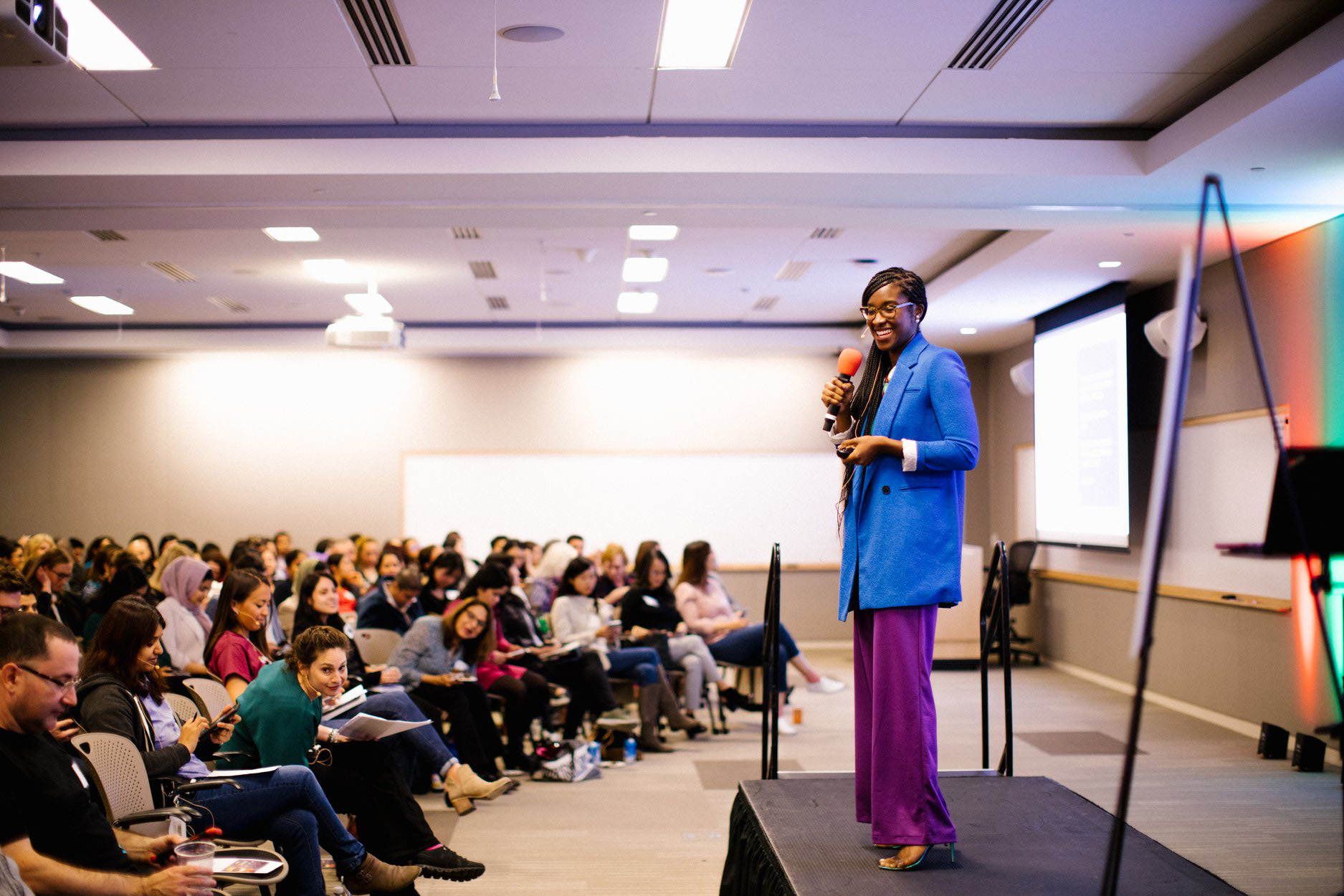 Microsoft Strategic Account Executive Safiya Miller gives a talk on what to do in the first 90 days of a new job at Microsoft Hardware Girl Geek Dinner. Erica Kawamoto Hsu / Girl Geek X
Microsoft Strategic Account Executive Safiya Miller gives a talk on what to do in the first 90 days of a new job at Microsoft Hardware Girl Geek Dinner. Erica Kawamoto Hsu / Girl Geek X
Safiya Miller: Didn’t you guys have awesome drinks and food outside? Come on. Well, everyone, my name is Safiya Miller. I’m super excited to be here. This is my first Girl Geek experience. I changed out of my Microsoft digs, but I am a Microsoft employee as well. By day I’m at Microsoft as a strategic account executive, Adobe’s my client. By night and by early morning, work-life integration that was just there, I am a fashion designer. Thank you. I’m wearing some of my pieces right now as well. If you have questions about how you can take advantage of pursuing your passions and really making the most out of what’s most important to you, definitely speak to me afterwards.
Safiya Miller: Today, I’m going to speak about the first 90 days. This doesn’t just mean the first 90 days in a new job, it means the first 90 days, particularly maybe at the same company, but in a new team. There’s three things you need to know and to make them count in Silicon Valley. They are managing yourself, managing team and colleagues, and managing the person that probably has the biggest factor of priority on your success at that company, managing your manager. Surprising to anybody, these three things? Make sense? Okay.
Safiya Miller: I know we’re at a Girl Geek hardware session, but these are critical for every portion industry of where you are in Silicon Valley for success, and I’ll tell you a little more about that right now. Managing yourself. The key to success is to start before you are ready. What does that mean? We talked about culture earlier. It’s one thing to read about a culture, to read about what Satya is doing, to hear what growth mindset means, but are you actually seeing it? Have you spoken to the Microsoft employees today and talked to them about what that means for them day to day? Was it a driver in them coming to this company? These are important things that you can figure out before you start, and you certainly should make a priority as soon as you’re on the job.
Safiya Miller: For me, this was important because I studied psychology and Spanish at Harvard undergrad, went into finance, a traditional analyst’s route after undergrad, and this managing yourself piece is important because I knew that working abroad was important to what I wanted to do in my career. As soon as I started, I was able to clearly identify something that was important in my career trajectory, which was an international experience. Managing yourself means you should have a blueprint of what’s important to you and your career, and where you want to see yourself.
Safiya Miller: That’s really important to identify in this first 90 days. You should also be able to identify how can this company, or this role, this team help you achieve those goals? Have you read the 10K? Have you listened to the latest earnings call? Have you spoken to anybody on your team about what the street really cares about for Microsoft, or for the company that you’re interested in, or the team that you’re on? What’s really moving the dollar, the needle? Those are the questions that sometimes get overlooked. But that’s really what’s keeping the lights on.
Safiya Miller: When you ground yourself in those things, this is how managing yourself sets you up for success. [inaudible] have a power outfit. I happen to be wearing one. You know what’s funny, because … and I know there’s a lot of allies in the audience, which is amazing. Can all the women raise their hands, all the women? [inaudible] raise the roof. Okay. All right. I just can make it clear here. I think we get a lot of feedback about what you should wear as a woman, specifically in tech, and how style doesn’t matter, or what you wear doesn’t matter. But if you think about it, can you easily identify what Steve always wore, audience?
Audience: Yes.
Safiya Miller: Okay. What about Scott? Scott Guthrie for our Microsoft employees, what is he known for?
Speaker 1: Red T-shirt.
Safiya Miller: Red T-shirt. Did I just say we were in an industry that said they didn’t care about style? Now, I’m not saying that it has to be glitz and glam, but they have something that’s predictable, something that makes their day to day easy on managing yourself. There’s so many speaking opportunities, there’s so many opportunities for women to thrive. I really feel like your brand, and what you’re wearing and presenting is just as important as what you have to say, and what you bring to the table.
Safiya Miller: This is just an example of a power outfit. I personally developed my fashion brand around statement pieces when I was speaking to women who were struggling with the most revered resource, time. They couldn’t think about what they could just pull out of their closet or travel with, to just have on the road and be ready to go on stage and command a room. So I made these statement pants.
Safiya Miller: But it doesn’t have statement pants for you, right? But I’m just giving you an example because pants for me are easy. I love color, and now I have a statement outfit that is a go to, when people think of Safiya, they know that when she commands a room, she’s going to have on a statement pants, she may have on a blazer, a fun pop of color, and she’s also going to tell you some awesome things about fashion. She might talk to you about what Adobe’s doing. It’s starting to build that story and predictability. Again, think about things that are manageable, that make the stress out of your life removed, because you have some routine that makes sense.
Safiya Miller: Let’s switch to managing your manager. I love these little cartoons. Who read any of these growing up? Yeah. All right, Career 101. This one stands out because there’s such a long list of priorities. But do you know the definition of priorities? Can you have a long list of priorities, and they really be priorities? Probably not. But this is important, because your manager only knows what you’re telling them. Right? There’s a variety of things that motivate each of us in this room to come and do our jobs day to day. It’s important to manage your manager so that they know what’s important to you. What’s the driver to you? Is it the money? Is the project that you work on? Is it creativity? Is it growth? Those kind of things are important for you to take ownership of and share with your manager so that they can be an advocate for you.
Safiya Miller: Force yourself to have those hard, but necessary, conversations with your boss. I know it’s hard, and I know that a lot of us procrastinate. I’ll raise my hand. Sometimes I do too, especially on those harder conversations. But guess what, the longer you wait to happen, the worse it is. Whether it’s a vacation that you already had planned, whether it’s through thinking through growth around the company, and maybe wanting to explore another team, but you need their advocacy, these kind of conversations that are important to you, that may seem challenging for your manager, a good manager is here to be an advocate for you, and really see you grow into an amazing employee, and potentially another manager if you want to be one yourself. But again, they only know that if that is something that you’ve expressed to them. Managing your manager, being clear, speaking up up front, those things work in your benefit.
Safiya Miller: Managing your team and colleagues. I’ll give you guys a second to just take this in. Does this girl talk about hardware? Why are you taking career advice from me? This is a good one because I think sometimes when we talk about mentorship and sponsorship, we get caught up in what that needs to look like. Do I need to be mentored specifically by Satya to make it to the top? There’s probably a short list of people who are going to actually have that opportunity.
Safiya Miller: But if you look around, right, about people that work hard, I’m not saying don’t work hard, you absolutely should, but work smart. Think about the people on your team that are working smart and are being acknowledged for what they’re doing. Right? Those are the people that you might want to take some time to spend with. Doesn’t necessarily have to be someone that’s two skip levels above you. Could be someone that’s right on your team. I think we under-evaluate sometimes our own peer network, and how powerful that is.
Safiya Miller: This comment speaks to it a bit. Networking horizontally. There was a study on LinkedIn where it says 70% of people that get positions in jobs already knew somebody at that company. Could have been a colleague or a classmate. Probably not the CEO. I’m just stating the facts here and the numbers.
Safiya Miller: Can everybody take out their phone if you don’t have it out. Okay. Go to the LinkedIn (mobile) app. Give you guys a minute, as you’re thinking about who you’re reaching out to, and turn on the Bluetooth. Okay? Bluetooth is already on? Great. Some of you may already know this hack, but I’m setting you up for success when I finish. Okay? Go to the bottom screen. There’s the five buttons. Five GUIs here, my network. Click on “My Network” and then on the bottom right, there’s an icon with the figure and a plus. You can either click “Find Nearby”, “OK”, or “QR code”.
Safiya Miller: Click on “Find Nearby”. You’re activating this entire room right now. Okay? I’m helping you save so much time for later. You’re welcome. This is fantastic. Honestly, the reason I’m sharing this is because, again, networking horizontally … No one’s on? These people next to you aren’t on? Just give it a second. Okay. Use this later when you go and connect outside as well. But this is fantastic when you’re in sessions where there’s a lot of people group like this.
Safiya Miller: The other thing you can also do is to find the QR code. Okay? Everybody has a QR code, you just scan it. Those are the two options. But this piece, before you go on and start adding everybody, this is huge. Can we have coffee, because I’m trying to do X, and I’d love to hear your advice on Y? I put this up here because can I pick your brain? Can we catch up, with no indication of time or when? Those are time sucks. You should be really intentional about the people that you want to network with. What specific skill set do they have that you want to learn more about? How are you trying to grow?
Safiya Miller: Be specific, be intentional, do your research. Trust me, the other person, the other side will be appreciative and more likely to take the time to meet with you and have that coffee. Do the homework. Follow up intentionally when someone gives you advice. Keep that connection open and going.
Safiya Miller: I gave you guys the gift early, but because you’re in … because I’m awesome. Thank you. Because we’re in the Bay Area, I’m going to also give you guys another gift, right, because I want to know who’s in the room. East Bay, can I hear East Bay? Okay. Berkeley. North Bay, Marin? Nobody? That’s kind of far. Okay. San Francisco, the city. South Bay. All right. They’re rollin’ deep.
Safiya Miller: Again, I’m trying to help you get these obvious things. Where do you live? Where’d you come from out the way? Most of you guys are in South Bay. Okay, you live in the bay. Get specific. You came here tonight. You have so much potential in the audience. What do you want to grow? Where do you see yourself at the end of the year? I’m certain someone in here can share something with you that will make that impactful and valuable. Make the most of your first 90 days, manage yourself, manage your team and your colleagues, and most certainly, manage your manager. Thank you so much.
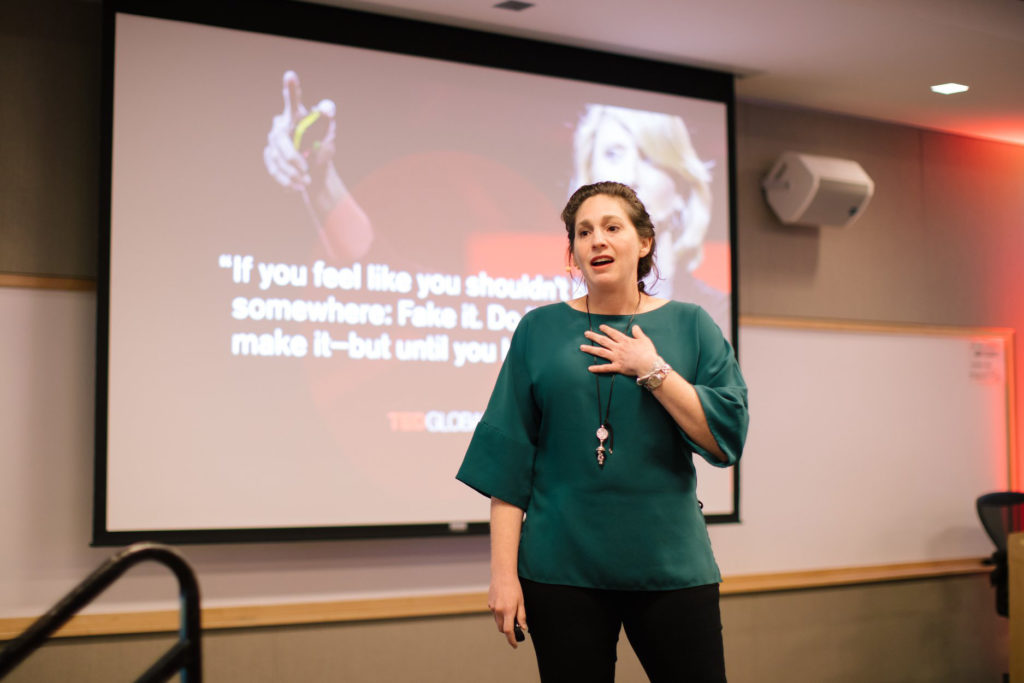
Microsoft Senior Director of Silicon & System Architecture Elene Terry gives a talk about how to leverage your silicon expertise to move into a category that lets you do your best work at Microsoft Hardware Girl Geek Dinner. Erica Kawamoto Hsu / Girl Geek X
Elene Terry: [inaudible]. Let’s see if this is working. Thank you. I’m going to start by taking you back to 2011. At the time, I was working at a semiconductor company, and it was working on super cool products. I was working on Xbox, I was working on graphics cards, and I was doing the work that I really love. But something was missing. I would go home, I complained to my husband about everything. I was unmotivated by work. I did an Iron Man. If you’ve ever trained for an Iron Man. It’s like a full time job just training for an Iron Man.
Elene Terry: My husband, he would say, “Elene, go fix it, go find another job, go find something that inspires you.” I did. I went out, I got several job offers, but I sat on them. In fact, I sat on one for almost six months. As I was thinking about them, I knew something was missing, but I couldn’t figure out what it was. Then I got my offer from Microsoft. As I contemplated the offer, I probably was thinking about it maybe the same way you’re thinking about it. Why would a hardware engineer go to Microsoft?
Elene Terry: I’m an ASIC design engineer by training, and at my previous company, there were thousands of people just like me. But as I thought about it, I thought, “If I go to Microsoft, I’ll be kind of unusual. I’ll have some opportunities that I didn’t have before.” I got really excited, and so I came to Microsoft. I took this risk and I came to Microsoft. I’m going to start by showing you a video. This was not put together for me, but it really resonates to my message. Let’s see if it start.
Elene Terry: When I came to Microsoft, I started by working on Xbox. This was what I was working on before. Thank you. Strings and cost downs. I worked on bringing 4K content to Xbox, pretty similar to what I was doing before. But then things started to change, and I worked on HoloLens as [inaudible]. The HPU, I’ll talk about a little bit more later. Silicon for the display, and then bringing that same technology to IoT devices. I think there’s an Azure Kinect out in hall, to go explore with. Then silicon for the data center. I think we have an Azure Stack Edge presentation later too. I’ll talk a little bit more about that. We can see it’s taken on a lot of different forms while I’ve been at Microsoft.
Elene Terry: You can see it’s been a totally exciting seven years for me. I’m going to start by showing you some examples. This is the HPU. I love this picture. It’s beautiful. The HPU is the Holographic Processing Unit. This is the main piece of silicon that’s in the HoloLens. When I came to Microsoft, I worked on HoloLens 1, the HPU 1. I used some of my expertise to work on interconnects and memory controllers. As time progressed, we worked on HPU 2. It’s a pretty small team, there were only five of us.
Elene Terry: Now, I had an opportunity to become the SOC architect. What that meant is I was responsible for trying to figure out everything that went in this piece of silicon. I would never have had this opportunity at my previous company. Remember, there were thousands of people like me, but at Microsoft, I had this opportunity. For instance, as I was working on the HPU, I was introduced to new techniques, things like low power, analytical models for low power, power projections, power modeling.
Elene Terry: At my previous company, there were people that did this. It was an entire team that did this. But at Microsoft, there was no one. I had to go and learn it, so there was just a small team of us trying to figure it out. It was super exciting.
Elene Terry: Then I got to work on the entire device. Remember, Microsoft is a vertical company, so meaning we build the entire device in-house. You can see the HPU is demarked by the heart. So I started to get to work on the device. This is what we call the MLB. I call it the crab board. You can see all these little notches cut out from it in order to fit in a thermally constrained environment. It was super cool, right? Because I was at Microsoft, I got to see this vertical integration. I got to work on things that I just didn’t have the exposure to prior in my career.
Elene Terry: As I started working on this, I started working on more and more different types of trade off analysis. At the time, I had no idea what they were called. I now call this work systems engineering. It meant I was working with all kinds of different teams. User experiences team, algorithms team, firmware team, silicon teams, mechanicals, ID, thermal teams, electricals and interconnect, system validation, sensors display, and I was doing trade off analysis between all of them.
Elene Terry: I’m not sure if people are familiar with the other picture of Microsoft on the internet. But this is how it’s like for me. What I found is that people, they wanted to work with me. They had not previously had this exposure to the hardware trade off analysis. So people from all of these disciplines wanted to work with me. They wanted to understand how their part of the system worked together. Then most recently, I’ve been pivoting to work on silicon in the data center. Taking all of those same experiences, trying to figure out how we can build silicon that leverages the experiences we have, and is able to go to scale in the data center.
Elene Terry: When I talked about all of this in the past, people have come up to me and said, “Elene, how did you have the confidence to make all of these transitions? How did you have the confidence–How did you convince your boss that you could do this?” The short answer is I didn’t. I would go home to my husband all the time, almost every night, and I would cry, and I’d tell him, “I don’t know what I’m doing. I am bad at my job. I don’t know what to do next.” But what was important is that I showed up at work with confidence.
Elene Terry: I adhere to fake it till you make it. I’m not sure if people are familiar with Amy Cuddy’s research. She has one of the most watched TED talks of all time, and her research is on power positions, and how power poses change our behavior. Why not? A superwoman pose. But what really resonated with me in her talk was when she talks about having a car accident when she was 19. When she was 19, as she’s recovering, she discovers that her IQ has dropped almost two standard deviations. She talks about how she recovers from that, how every time she goes to a new role, she feels like she has to fake it.
Elene Terry: She says she just kept faking it one step at a time until she becomes a Harvard researcher. She says, “If you feel like you shouldn’t be somewhere, fake it, do it not until you make it, but do it until you become it.” The reason that really resonated with me is because you have to fake it, not just till you make it, not just until you are able to do the job, but you have got to fake it until you become it, in the sense that I had to fake it until I felt comfortable doing the job, that I didn’t go home and cry every evening that I couldn’t do my job.
Elene Terry: What does this mean for you? For me, it meant that I was able to leverage my unique expertise to really step out of my box, out of my comfort zone, and be able to leverage that for new experiences. I’m now running an organization that works on all of the roles that I talked about today. For me, I’ve so much more motivated. I come to work present and excited. I have no more time to run an Iron Man. I’ve just been so lucky to be able to identify where I fit in. What I hope for all of you is that you’re able to leverage that, your own unique talent, to find your own niche, to find something that motivates you and allows you to bring your best self.
Elene Terry: Thank you so much. I’m going to be outside answering questions about silicon, hardware, and I’d love to talk to all of you about anything in Microsoft.
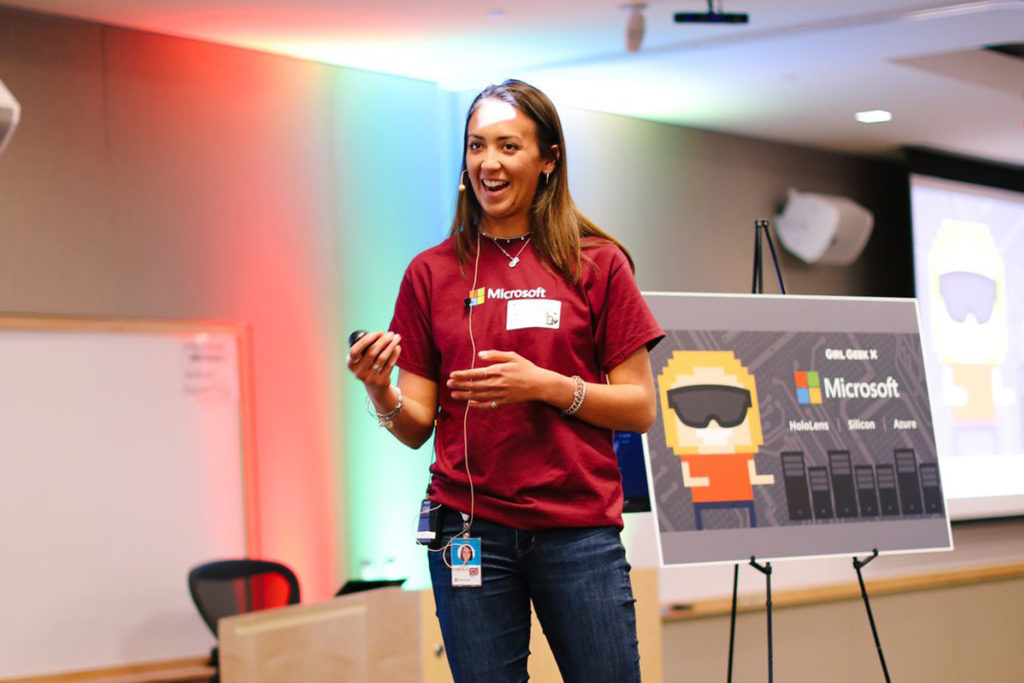 Microsoft Mechanical Engineer Carolyn Lee gives a talk on HoloLens at Microsoft Hardware Girl Geek Dinner. Erica Kawamoto Hsu / Girl Geek X
Microsoft Mechanical Engineer Carolyn Lee gives a talk on HoloLens at Microsoft Hardware Girl Geek Dinner. Erica Kawamoto Hsu / Girl Geek X
Carolyn Lee: Hello, how’s it going? All right. Mics are good to go. Hi, everybody. I’m Carolyn, and I am an engineer on the mechanical team for HoloLens. When Josh asked me to speak at this event, at first, I wasn’t exactly sure. This isn’t something I normally do. I realized I get to stand up here and talk to you guys for 10 minutes about something that I look forward to waking up and working on every day. So let’s just get right to it.
Carolyn Lee: A little bit of background about myself. I started off at Microsoft as an intern during the summer of 2017. They were crazy enough to let me to come back the summer of 2018 to intern again, and I started as a full time engineer here last August during the summer of 2019.
Carolyn Lee: Before we get going, how many of you guys know what HoloLens is? Nice. Awesome. How many of you guys have gotten to try HoloLens 2? Great. For those of you that haven’t, I would highly recommend trying out one of the demos outside before you go. We have Silicon Valley’s finest out there leading all of the demos. For those of you that don’t know what HoloLens is, HoloLens is an augmented reality or mixed reality device that projects laser images onto your eye to allow you to overlay holographic images on your real world.
Carolyn Lee: Unlike virtual reality in which everything that you’re seeing around you is fake, augmented reality actually allows you to see the world around you, put objects onto that world, and it enhances the way that you can interact with your space as well as people, both near and far from you. HoloLens 1 was actually released as a dev kit. It was released for developers to come up with software and create programs that would run on this device, which created a really interesting environment because it was now being used across a wide variety of industries in which developers thought it would be most useful.
Carolyn Lee: One of these industries was the medical field. Doctors can actually wear this device and overlay CAT scans on their patients to know exactly what they’re operating on before they start an operation. I was actually talking to my sister on the phone the other night, and she had mentioned how one of her friends in med school uses HoloLens as their main training device for one of their classes, which I thought was super cool, one, for the use, and also because he just mentioned this in passing because he thought it was so cool, not because he knew that she had a sister that worked on HoloLens.
Carolyn Lee: What does our product design team here actually do for HoloLens? Our product design team creates all the parts that you can actually feel and see in the product. That’s everything from design to manufacturing, to assembly, to troubleshooting later on. We’re working cross-functionally with our sensors team, our optics team, our EE team, human factors to make sure that we’re taking in all the user research into account, to try and create a device that’s going to meet everybody’s needs and requirements, and create the best experience for the user itself.
Carolyn Lee: A little bit about my career here. I started off as an intern back in the summer 2017, like I said before, and my first summer I was working on scaling the fit system prototype. The fit system is how the device actually goes on to your head, and scaling being taking it from one device to say 20 prototypes that we could then use in user studies. This is particularly relevant because one of the main points of feedback that we got from HoloLens 1 was that the device needed to be more comfortable. This is important because when a user puts on the device, we want this to be an immersive experience. We want them to transition from reality to mixed reality without even knowing that they’ve put this device on their head. That’s why comfort was so important.
Carolyn Lee: I got to work with a great manager who had did a bunch of research into what the center of gravity of the device was, what moment was this putting on your neck, how is this affecting the user experience, how heavy was the device, how could this device actually be worn for an extended period of time? I got to work on trying to scale a prototype that was going to be then be used for human factors research. Then with that, I also got to work with a super experienced engineer who was my mentor throughout my two internships, and pick his brain on how he did design, and what was important to him, and what were things that he was looking for.
Carolyn Lee: With that, it was a very hands-on experience, because with prototyping, comes actually creating the prototypes. HoloLens has a great resource here in the Silicon Valley. Brian Golden in the back leads our machine shop, and I got to work with them a lot. Yes, big round of applause for Brian. I got to work with them a lot throughout this process, and really what it did for me in my first internship ever, that summer after sophomore year of college, was take academia and make it real. It made it tangible, and it made me excited to continue on the mechanical engineering track, and made me really excited to come back the next summer.
Carolyn Lee: The next summer I came back, and I actually got to own my own part that summer. It’s a very small part, so I could actually run it through the whole design cycle in that three months. Designing it, working with vendors overseas to get it manufactured, bringing it back here, working in the shop to run it through some lifecycle testing to see how this is actually going to perform over the span of its time, and use this to inform our design later on. I really enjoyed the responsibility of getting to own my own part and work with different teams.
Carolyn Lee: I got to work with the reliability team a lot that summer to understand a broader scope of the design cycle, which became really important when I was working as a full time engineer, because right when I started we hopped into our first, or I hopped into my first full fledged design cycle. There wasn’t really much in the way of bringing up time, but I actually liked that because it made me feel like I was coming in and making an immediate impact that I was going to get to be able to work on meaningful work right away, which I really enjoyed.
Carolyn Lee: My first internship, it made academia real. My second internship gave me a dose of what the design cycle is like, and being here full time, I think I’ve started to realize how much the people are super important. The first two summers, I got to work with a great manager and a great mentor that gave me a little taste of that. But coming back full time, I realize how important it is to be surrounded by people that want to help you learn, want to help you grow, and are all working towards the same goal.
Carolyn Lee: An example of that is Edwin, who was one of the other engineers on our team, had plenty on his plate to keep him busy during this design cycle. But he was working on parts. He had worked on parts in the past that were similar to what I was working on now, and whenever I needed help with anything–I had a lot of questions starting out, and whenever I needed help with anything, he was always right there to help me. “What can I do to help you? What resources can I provide?” If he didn’t know the answer, he knew who to tell me to talk to, to find out that answer.
Carolyn Lee: I think the most impressive part about that was, I never once felt like he was rushing to get back to his own work, even though he had plenty there to keep him busy. He was there to make sure that I could be as successful as possible. On the other side of it, not just in terms of technical support, being early in my career, and not always knowing where to go and what to do, Teresa, who shares the office next to me is in the back, she’ll love the attention, was really great about making sure that I knew what to look for in my career at this point. She said, “I was in your shoes four years ago, and here are the things that you should be looking for, and this is what you might want to look out for in terms of your career, and what do you want to do.”
Carolyn Lee: It was really nice to be able to have resources both on the technical side, and I felt like my peers were looking out for me in terms of making sure that I felt as supported as I needed to, which as a young engineer looking for a job and trying to figure out where exactly I want to take my career early on, I think the thing that was most important to me was that I was going to be somewhere I felt like I could develop, and that I could learn, and I was going to be pushed to grow as an engineer.
Carolyn Lee: I think that one of the most exciting things about working on HoloLens is that it’s challenging. This is something that I remember from my very first interview back in the winter of 2016, when I was sitting in the room with Roy, who leads our mechanical team. He had said, “When you’re designing a product, you start off by looking at what’s been done before. You work on there and see which parts of this do we want to keep, which parts of this are we going to move away from?” He said that when they were creating HoloLens as an AR device, and they looked for examples, there were no examples. AR hadn’t been done before.
Carolyn Lee: That was exciting. It was challenging, there was no example to look at, but it was exciting because we get to be the people that create that example, that later on one day, a company is going to look at how they’re going to do this, and they’re going to look at HoloLens. We get to design the track that AR is going to take in the future. HoloLens, I felt was a place where I was going to be pushed as an engineer, I was going to be surrounded by bright and hardworking individuals, and it’s an opportunity to work on cutting edge technology, cutting edge technology that’s expanding industries and paving the path for what AR can do and will do to change our future. Thank you.
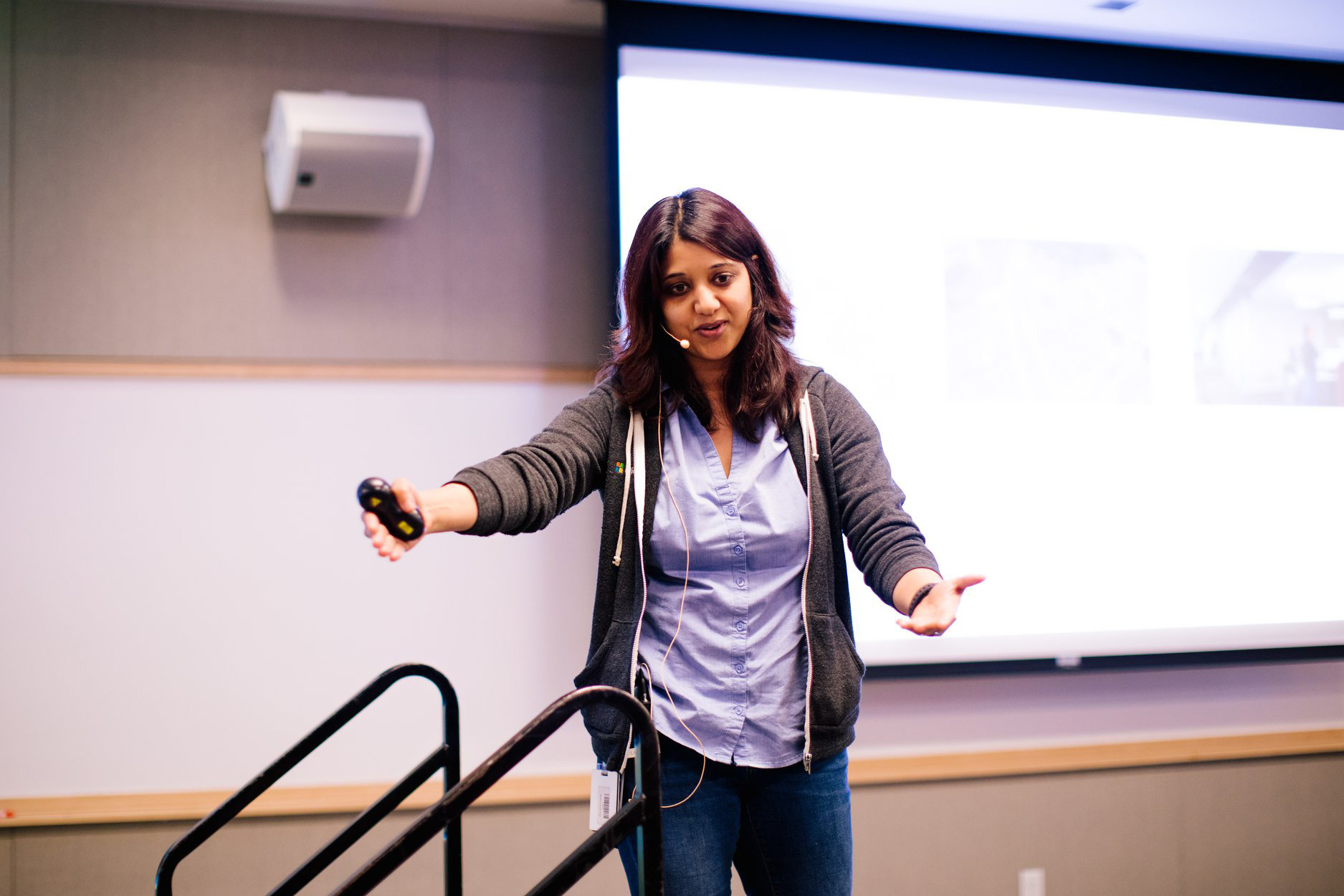
Microsoft Product Manager Shivani Pradhan gives a talk on Edge Computing at Microsoft Hardware Girl Geek Dinner. Erica Kawamoto Hsu / Girl Geek X
Shivani Pradhan: [inaudible]. Oh, it gets better. We start with a very nice ad that they made. (music)
Shivani Pradhan: That’s the Azure Stack Edge device, and I’m a PM Azure Stack Edge team. I’ve been around for almost 19 years with a lot of engineering and business side experience at this point. I’m pretty new to Microsoft. I’ve been here, actually, just like Carolyn, I joined full time in August 2019, so almost six months now. The best thing I feel about Microsoft today is people. It feels like home.
Shivani Pradhan: My team was building these two products, and so they’ve been working really long, really, very hard. Being new in the team, when you approach somebody, you’re being mindful of not wasting their time. Also being conscious that you don’t want to take any dumb question to them. But everyone has been so embracing, so welcoming, not a frown on anybody’s face that you’re wasting their time. That’s very, very supporting. That is really encouraging at the same time. I’ve really enjoyed my ride last seven months, and I would encourage all of you to apply to Microsoft.
Shivani Pradhan: What is Edge Computing? Think of cloud computing and the cloud capabilities. Capabilities like artificial intelligence, machine learning, and pushing them from a public cloud to all these physical devices that are connected. Cloud ability on the Edge is basically Edge computing. You may ask, “Why bother, because a lot of these physical devices do not have great connectivity? In fact, a lot of them don’t have any connectivity at all.” In those circumstances, you want the compute power on the Edge, very close to the data because data has gravity.
Shivani Pradhan: That’s where Edge computing comes in. Microsoft over here has a wide range of devices that they bring to you for the intelligent Edge, literally from hyperscale cloud, where they have availability in 56 regions and over 140 countries to small integrated chips that they’ve put in every coffee machine with extremely high security, mindful of all the capabilities that they can bring to a coffee machine that is connected to the cloud, bringing the cloud capabilities to that machine, but the same time, making sure it’s super secure.
Shivani Pradhan: Right in the middle is the Edge device. That’s the team that I work for, and that’s one of the Azure-managed AI-enabled compute appliances that we build. It comes with hardware accelerated FPGAs. Those are integrated circuits, or Nvidia, supported Nvidia’s GPUs that you can put in there to really put high amount of boost power behind whatever compute you’re doing. You can run VMs on it, you can run Kubernetes on it. The best part is it’s completely Azure-managed, which means you go to Azure portal, you deploy your device, you can completely manage it without worrying about your IT. You can create a custom app and just push it to all your physical devices.
Shivani Pradhan: In addition to that, it is a storage gateway, which means in your disconnected mode, you have petabytes of storage to store data locally, and then you can push it to the cloud at your own pace, at your own schedule. Edge devices cover a variety of use cases. Some of the most popular ones are machine learning on the Edge. One of the most common cases that we are seeing is running intelligent AI and machine learning inferencing on the Edge.
Shivani Pradhan: For example, let me give you an example of Kroger, which is trying to look for shelf spaces which are empty. They run an AI model to detect those empty spaces. But what they found was that if they are last couple of boxes remaining, those shelves do not detect as empty. Interestingly, there’s a psychology behind when we go to pick a box, and that’s the last box, we don’t pick it. We’re like, “There must be something wrong. Why didn’t anyone else pick it?” There’s the last box of Cheerios. You look at it, and you’ll put it back, and you will not walk away with it. That shelf is not empty because it has one box sitting there.
Shivani Pradhan: They developed an intelligent AI model to actually detect that now there’s only one or two last boxes left. So instead of a customer walking and saying, “Hey, you’re out Cheerios,” or somebody walking up and down the aisle, and saying, “Okay, Cheerios out, this out, that out.” The model detects and right away informs, and so suddenly, your supply chain is working better. You’re keeping it stocked.
Shivani Pradhan: The second popular use case is Edge compute and IoT solutions. I have a full slide on that one, and the network transfer where you can actually decide your own pace of transferring your data to the cloud. Machine learning on the Edge is another very popular use case with drone footage. But I have an even better example. We all have seen or got messages on our phones when cops are looking for a specific car, where we see say, “Okay, this car, if you see it, please text.”
Shivani Pradhan: Think about it. We have tons of traffic police cameras all over the city. They all are collecting that feed. That feed gets collected, sent to the cloud. Six hours later, it tells the police saying, “That car passed over there, over there, over there.” Six hours later. Come on. In 2020, you want it to be instant. It should have said, “The car is passing this now, now,” so you can track it. Now, instead of blasting millions of people on their phone saying, “Did you see this car?” Right? That’s the immediate results of Edge processing, right, that camera could have directly, just on that quick processing on the Edge. It didn’t need to collect 20 petabytes of data, it just needed to do that quick inferencing and react to that. That reactivity, that quick response comes with reacting on the Edge, being closer to the data.
Shivani Pradhan: Similarly, filter with AI analysis. That’s near collisions. That’s actually something that state of Washington, couple of cities in state of Washington are already doing, where they’re collecting only one minute of data. They have AI models to figure out that a collision happened, or almost a near collision happened. They try to cut off the video feed 30 seconds before and after, and just that one minute is sent for further analysis, and figuring out, and influencing the traffic engineering. That is pretty cool.
Shivani Pradhan: Then lately, a lot of influence around privacy. We could actually do a lot of identification and blur it, blur the license plates, blur people’s faces. As your private data is anyways being shared, you at least feel a little at peace that it was not my face, that all the Google cars are collecting all over Mountain View. The last of the three cases that had [inaudible], the Edge compute and IoT solutions. You have, if you look at your phone today, you have tons of apps. But if you go and turn your WiFi off right now, 90% of the apps stop working. That’s because they are all cloud-based applications, and that’s where the world is headed.
Shivani Pradhan: Sure, we all have cloud-based apps. But that said, you want your cloud-based apps to work when you are in the basement, or when you are going through a tunnel, or in a deep forest. That’s what the Edge does for you. You actually continue running all your business cloud applications on the Edge, even in a disconnected mode. But at the same time, there’s certain legacy business apps, which were always made for the native applications, which do not run on the cloud. Your entire 90% of the portfolio has already migrated to the cloud. But now, you have these native apps that won’t run. Edge comes perfectly in the middle to connect the two places over there.
Shivani Pradhan: Then you have the perfect scenario where you actually want to take your applications down into the field. Like you were seeing in that very nice, fancy ad, things have broken down. Everything is not there, and you still need your maps, and you go to your online maps, they won’t work because the wires are down. But your Edge would work, and you can still do the overlays, you can still run your AI models, your drones can still fly around, take pictures, create overlays on top of that model. You update your model live on the Edge, and then you distribute at least to the disaster recovery teams, and they can keep working. So that’s taking applications into the field.
Shivani Pradhan: Then the most popular case, that’s how most of the Edge solutions started, was to do with transferring your data to the cloud. As more and more companies were trying to migrate, a lot of them constantly make a lot of data, and they want to keep pushing. But then there are some that want one large migration to go all of a sudden, and then those who know the Big O notation comes in over here saying, “Don’t send it over a pipe for 300 years. Right? Just put it on a plane and ship it, and that would be faster and cheaper.” That same way, you can decide your different models that works the best for you, and you could manage first because you only have a 10 millimeter pipeline, versus a big migration, versus constantly sending. You have all your options. It’s up to you. It’s your custom solution.
Shivani Pradhan: Esri is a company that actually works on providing maps, specifically in map-based technology for disaster situations. One of the previous examples I was giving was actually, that’s what Esri does. They, in a disaster situation, they load up a typical truck with sensors, cameras, drones, and an Edge, and they drive into the disaster zone. These drones fly around and take all kinds of pictures. Those pictures come back. Now, you have all kinds of junk as well in that picture. You run AI models on it and find the points of interest. Then you create overlays on the fly, and then you merge those overlays with your existing maps. Then you have a new map, which says, “Okay, two kilometers from here, you have a bridge broken. From here, there’s a fire, which is literally 0.5 miles away.” You can convert it on the fly of what data is important to that team, what are they looking for? Then you update the maps, and you’re able to actually do really effective work. This is something Esri is using Edge for today.
Shivani Pradhan: Let me tell you the story about this. This was a last minute slide. I’m so sorry. Doesn’t have a title. A few years back, there was a huge Ebola outbreak in Liberia, and USAID response team was put together and deployed to go work on a response for this. The team, when they landed on the ground in Liberia, their first task was to just find information and categorize information. That was not easy because they needed to go find out the state of healthcare centers, hospitals, find out the state of WiFi, find out the population density centers in that area. It was a very challenging task.
Shivani Pradhan: As they started piecemealing all that information together, this is a real whiteboard of that team that they put together. If you look at this, this is such a horribly complex and convoluted map to figure out how they’re going to provide support to healthcare centers in that environment with Ebola all around you. This was their index file. This was their index file to figure out things. The Edge team took on this mission saying, “Okay, how could we have helped them?” We did exactly that. We created an app in Azure on the cloud to actually just go and find information, and categorize information. But then, just what Edge is supposed to do, we decided to use cloud capabilities and enable all the cloud capabilities to it.
Shivani Pradhan: This is an Edge, which is actually running in a disconnected mode, and we uploaded a bunch of maps to it. Once you uploaded all the maps, it processed all those maps, and so you have some default information, PDFs, pictures, JPEGs, documents that have already been uploaded. Now, when you start enabling all the cloud cognitive services, so first thing that we would do is search for, it’s Ebola, healthcare centers. We could just search for the word hospital, for example. When you search for hospital, a healthcare facility comes up, various PDFs come up, and everything. But you look at that, that’s a JPEG. Okay. When you look at the JPEG, and you look specifically, enable the OCR on it, it can now convert the JPEG into readable doc. It can find text in it, and it has been able to detect all the hospital words in it.
Shivani Pradhan: Not only that, it actually found a French document, which also had a translation of the word hospital. I can’t see any word hospital over here. But when you go into translation, you actually see that it found the word hospital in the French translation of that. Like, “Okay, that was cool. I didn’t know French, but I did find that there is some hospital, which French organization found over there.” Now, when I go and look up the word Lofa, now, Lofa is where the Ebola had originated. It was the ground zero for that. When I looked at that, at that time, this map comes back. Why did it come back? Because the OCR technology in the cognitive services has a feature where it can actually read handwriting.
Shivani Pradhan: Not only that, it changed the JPEG into a readable format. It detected handwriting, and was able to read the word Lofa on that picture of the whiteboard. That was pretty enabling, and that was pretty helping. That’s all. Thank you so much.
Aaratee Rao: [inaudible] you hear me? All right. What an amazing set of talks. Can hear one more round of applause [inaudible].
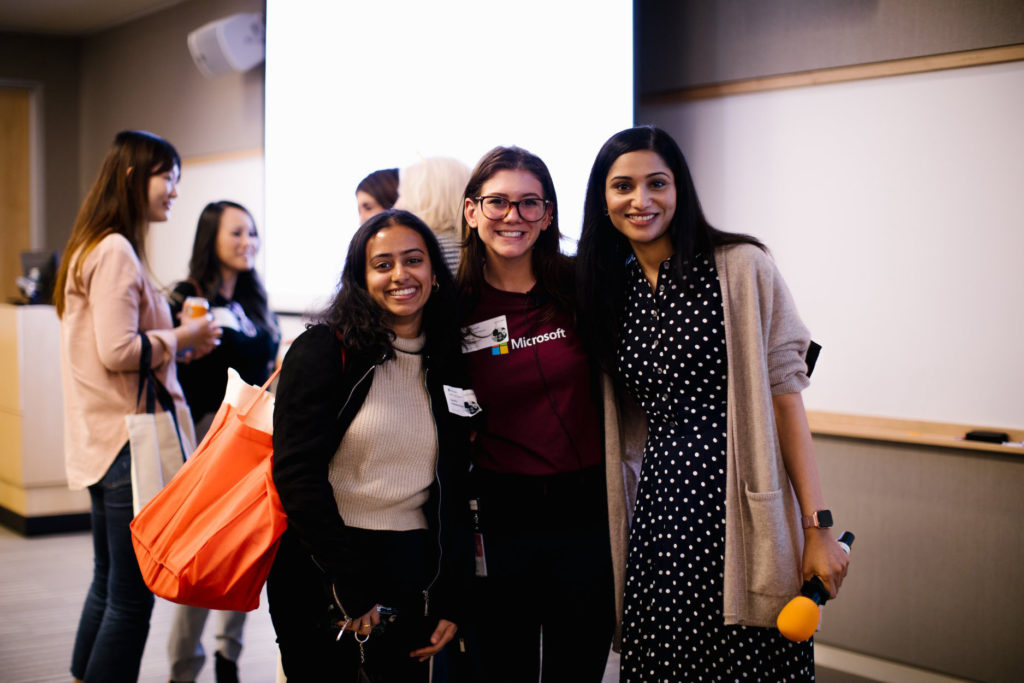
Like what you see here? Our mission-aligned Girl Geek X partners are hiring!
- See open jobs at Microsoft and check out open jobs at our trusted partner companies.
- Find more Microsoft Hardware Girl Geek Dinner photos from the event – please tag yourselves!
- Does your company want to sponsor a Girl Geek Dinner in 2021? Talk to us!



